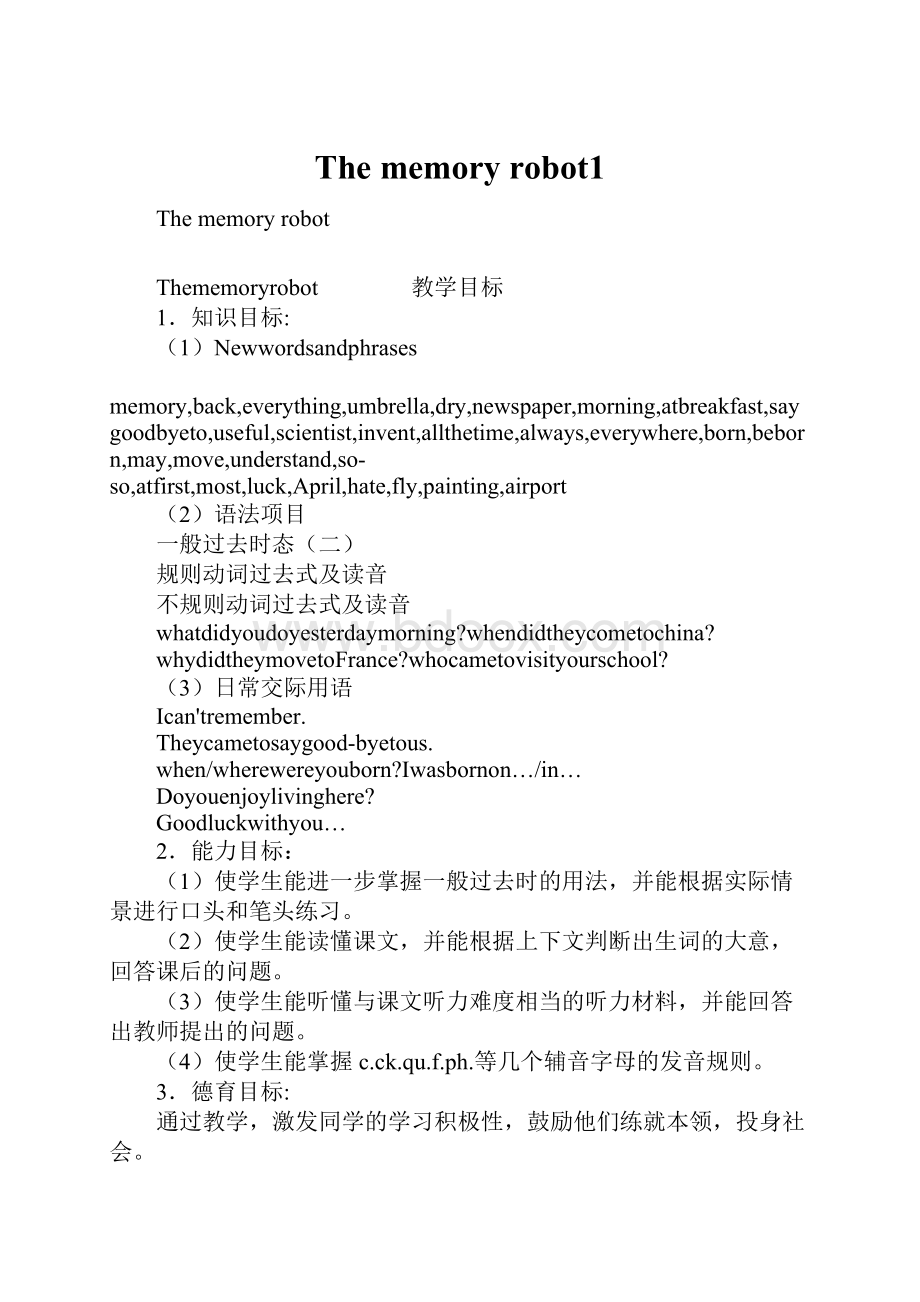The memory robot1.docx
《The memory robot1.docx》由会员分享,可在线阅读,更多相关《The memory robot1.docx(20页珍藏版)》请在冰豆网上搜索。

Thememoryrobot1
Thememoryrobot
Thememoryrobot 教学目标
1.知识目标:
(1)Newwordsandphrases
memory,back,everything,umbrella,dry,newspaper,morning,atbreakfast,saygoodbyeto,useful,scientist,invent,allthetime,always,everywhere,born,beborn,may,move,understand,so-so,atfirst,most,luck,April,hate,fly,painting,airport
(2)语法项目
一般过去时态
(二)
规则动词过去式及读音
不规则动词过去式及读音
whatdidyoudoyesterdaymorning?
whendidtheycometochina?
whydidtheymovetoFrance?
whocametovisityourschool?
(3)日常交际用语
Ican'tremember.
Theycametosaygood-byetous.
when/wherewereyouborn?
Iwasbornon…/in…
Doyouenjoylivinghere?
Goodluckwithyou…
2.能力目标:
(1)使学生能进一步掌握一般过去时的用法,并能根据实际情景进行口头和笔头练习。
(2)使学生能读懂课文,并能根据上下文判断出生词的大意,回答课后的问题。
(3)使学生能听懂与课文听力难度相当的听力材料,并能回答出教师提出的问题。
(4)使学生能掌握c.ck.qu.f.ph.等几个辅音字母的发音规则。
3.德育目标:
通过教学,激发同学的学习积极性,鼓励他们练就本领,投身社会。
教学建议
教材分析
本单元的教学活动主要是教会学生如何谈论过去的经历。
为此课文做了精心设计,以mr.mott夫妇和hismemoryrobot之间发生的故事开展教学活动,一般过去时的教学贯穿始终,重点突出了谓语动词为实义动词的一般过去时的用法。
不但包括了实义动词一般过去时的陈述句形式还包括了一般过去时的一般疑问句和特殊疑问句形式,使整个教学活动重点突出,内容丰富。
教学重难点:
一般过去时及动词的过去式的拼写和读音。
单词教学建议
本单元单词数量多而且出现了大量的不规则动词的过去式学生难以掌握,教师应注意循序渐进,可以先让学生在课文中找出那些是动词的过去式,然后将这些词写在黑板上帮助学生在不规则中找出规律,再加深记忆。
如:
get-got,forget-forgot
begin-began,sing-sang,give-gave,swim-swam
say-said,pay-paid
know-knew,grow-grew,throw-threw
cut-cut,let-let,hurt-hurt,put-put,read-read
教师可以在每一节课抽出几分钟时间用听写,或提问的方式练习一部分动词的过去时,积少成多。
课文教学
第34课是一篇介绍mott先生和机器人的阅读课文和有关此文的问答。
可利用课文前面的两个问题让学生先进行讨论。
关于机器人的作用不一定非要局限在课文内容中,但教师也可借助这两个问题培养学生的略读能力:
给他们一分钟的时间默读课文并回答这两个问题。
接着再读一遍,然后回答练习册中的问题。
文中有的生词可在读前先给以介绍,但大部分生词可以让学生通过上下文猜测词义。
在此基础上,教师可结合课文本身有重点地讲解文中生词和难点。
本课的最后一部分问答练习让学生边填空边问答,实际上是测试学生对课文细节的理解能力。
对于条件较好的班级,应要求不看课文进行这个练习。
口语教学建议
教师可以出示一组句型转换的练习帮助学生熟悉一般过去时的用法。
如:
1.Heoftengetsupatsix.Butyesterdayhe________atseven.
2.myfatheralwaysbuysacakeformeeveryyearonmybirthday.Butlastyearhe______abookforme.
3.Tomalwaysplayschesswithpeter.Butyesterdaypeter_______.
听力教学建议
教学中,教师应先让学生仔细听清动词过去式发音,并注意跟随教师模仿。
再在听力材料中挖去动词的过去式,听完之后,要求学生填充所缺的单词,最后可以让学生跟读课文。
语法教学建议
本单元的语法教学应主要围绕一般过去时展开,教师应设计各种情景,给学生提供机会练习。
(1)教师可以在黑板上画一张教室图,门前有棵树。
编一段对话,借这棵小树之口向小鸟按下表介绍小明过去和现在在校的表现:
Time
Activities
Time
Activities
Lastyear
careless
Now
morecareful
Lastsummer
Swim
Thissummer
Playfootball
Lastterm
Likechinese
Thisterm
LikeEnglish
Tree:
Iamthetreeintheschool.IknowXiaomingwell.EverydayIseehimstudyintheclassroom.
Bird:
wasXiaomingacarelessboy?
Tree:
yes,Heoftenforgothisglasseslastyear.Heevenforgotthetelephonenumberofhisfamily.
Bird:
Doesheoftenforgetanythingnow?
Tree:
No,hebecamemorecarefulnow.
Bird:
DidXiaominglikechineselastterm?
Tree:
yes,butthisterm,helikesEnglishbetterthanchinese.
Bird:
whatsportsdidXiaomingdolastsummer?
Tree:
Heoftenswamlastsummer.
Bird:
whenandwheredidheswimlastsummer?
Tree:
Heoftenswamintheriverafterschool.Butthissummerhealwaysplaysfootball.
(2)教师可以要求学生将第三十三课第二部分按对话的内容改写成一篇日记以加深学生对对话的掌握如下:
Igotupat6:
45.Iwentforawalkandboughtanewspaperbeforebreakfast.Ireadnewspaperatbreakfast.Afterbreakfastmr.andmrs.Turnercametoseeme.Hestartedpackingat9:
15andfinishitat10:
40.
need“需要”注意的几个方面
1)need名词,意思是“需要、必要”。
其复数形式是“必需品”。
例如:
Thereisnoneedtohurry.没必要着急。
Ifeeltheneedofexercise.我觉得需要运动。
weareinneedoffood.我们需要食物。
need用作不可数名词时,还有“贫穷、不幸、逆境、困难”等意思。
例如:
manyfamiliesareingreatneed.许多家庭处于贫困的情况。
Afriendinneedisafriendindeed.患难见真情。
2)need用作实义动词时,意思是“需要、必须、必要”。
例如:
mycoatneedsmending.我的上衣需要缝补。
Ineedsomemoney.我需要一些钱。
weneedtoworkhard.我们必须努力工作。
3)need用作情态动词时,意思是“需要、必须”,常放在疑问句和否定句中。
例如:
Needhego?
=Doesheneedtogo?
他必须去吗?
“mustIdomyhomeworknow?
”“我现在必须马上做作业吗?
”
“No,youneedn’t.”“不,不必。
”
注意:
need作情态动词时,因为无人称和时态的变化,所以它的过去时用hadto来代替,而将来时则用willhaveto来代替。
例如:
Hehadtogetupearlybecausehewantedtoclimbthehills.
他必须早起因为他想去爬山。
教学目标
1.知识目标:
(1)Newwordsandphrases
memory,back,everything,umbrella,dry,newspaper,morning,atbreakfast,saygoodbyeto,useful,scientist,invent,allthetime,always,everywhere,born,beborn,may,move,understand,so-so,atfirst,most,luck,April,hate,fly,painting,airport
(2)语法项目
一般过去时态
(二)
规则动词过去式及读音
不规则动词过去式及读音
whatdidyoudoyesterdaymorning?
whendidtheycometochina?
whydidtheymovetoFrance?
whocametovisityourschool?
(3)日常交际用语
Ican'tremember.
Theycametosaygood-byetous.
when/wherewereyouborn?
Iwasbornon…/in…
Doyouenjoylivinghere?
Goodluckwithyou…
2.能力目标:
(1)使学生能进一步掌握一般过去时的用法,并能根据实际情景进行口头和笔头练习。
(2)使学生能读懂课文,并能根据上下文判断出生词的大意,回答课后的问题。
(3)使学生能听懂与课文听力难度相当的听力材料,并能回答出教师提出的问题。
(4)使学生能掌握c.ck.qu.f.ph.等几个辅音字母的发音规则。
3.德育目标:
通过教学,激发同学的学习积极性,鼓励他们练就本领,投身社会。
教学建议
教材分析
本单元的教学活动主要是教会学生如何谈论过去的经历。
为此课文做了精心设计,以mr.mott夫妇和hismemoryrobot之间发生的故事开展教学活动,一般过去时的教学贯穿始终,重点突出了谓语动词为实义动词的一般过去时的用法。
不但包括了实义动词一般过去时的陈述句形式还包括了一般过去时的一般疑问句和特殊疑问句形式,使整个教学活动重点突出,内容丰富。
教学重难点:
一般过去时及动词的过去式的拼写和读音。
单词教学建议
本单元单词数量多而且出现了大量的不规则动词的过去式学生难以掌握,教师应注意循序渐进,可以先让学生在课文中找出那些是动词的过去式,然后将这些词写在黑板上帮助学生在不规则中找出规律,再加深记忆。
如:
get-got,forget-forgot
begin-began,sing-sang,give-gave,swim-swam
say-said,pay-paid
know-knew,grow-grew,throw-threw
cut-cut,let-let,hurt-hurt,put-put,read-read
教师可以在每一节课抽出几分钟时间用听写,或提问的方式练习一部分动词的过去时,积少成多。
课文教学
第34课是一篇介绍mott先生和机器人的阅读课文和有关此文的问答。
可利用课文前面的两个问题让学生先进行讨论。
关于机器人的作用不一定非要局限在课文内容中,但教师也可借助这两个问题培养学生的略读能力:
给他们一分钟的时间默读课文并回答这两个问题。
接着再读一遍,然后回答练习册中的问题。
文中有的生词可在读前先给以介绍,但大部分生词可以让学生通过上下文猜测词义。
在此基础上,教师可结合课文本身有重点地讲解文中生词和难点。
本课的最后一部分问答练习让学生边填空边问答,实际上是测试学生对课文细节的理解能力。
对于条件较好的班级,应要求不看课文进行这个练习。
口语教学建议
教师可以出示一组句型转换的练习帮助学生熟悉一般过去时的用法。
如:
1.Heoftengetsupatsix.Butyesterdayhe________atseven.
2.myfatheralwaysbuysacakeformeeveryyearonmybirthday.Butlastyearhe______abookforme.
3.Tomalwaysplayschesswithpeter.Butyesterdaypeter_______.
听力教学建议
教学中,教师应先让学生仔细听清动词过去式发音,并注意跟随教师模仿。
再在听力材料中挖去动词的过去式,听完之后,要求学生填充所缺的单词,最后可以让学生跟读课文。
语法教学建议
本单元的语法教学应主要围绕一般过去时展开,教师应设计各种情景,给学生提供机会练习。
(1)教师可以在黑板上画一张教室图,门前有棵树。
编一段对话,借这棵小树之口向小鸟按下表介绍小明过去和现在在校的表现:
Time
Activities
Time
Activities
Lastyear
careless
Now
morecareful
Lastsummer
Swim
Thissummer
Playfootball
Lastterm
Likechinese
Thisterm
LikeEnglish
Tree:
Iamthetreeintheschool.IknowXiaomingwell.EverydayIseehimstudyintheclassroom.
Bird:
wasXiaomingacarelessboy?
Tree:
yes,Heoftenforgothisglasseslastyear.Heevenforgotthetelephonenumberofhisfamily.
Bird:
Doesheoftenforgetanythingnow?
Tree:
No,hebecamemorecarefulnow.
Bird:
DidXiaominglikechineselastterm?
Tree:
yes,butthisterm,helikesEnglishbetterthanchinese.
Bird:
whatsportsdidXiaomingdolastsummer?
Tree:
Heoftenswamlastsummer.
Bird:
whenandwheredidheswimlastsummer?
Tree:
Heoftenswamintheriverafterschool.Butthissummerhealwaysplaysfootball.
(2)教师可以要求学生将第三十三课第二部分按对话的内容改写成一篇日记以加深学生对对话的掌握如下:
Igotupat6:
45.Iwentforawalkandboughtanewspaperbeforebreakfast.Ireadnewspaperatbreakfast.Afterbreakfastmr.andmrs.Turnercametoseeme.Hestartedpackingat9:
15andfinishitat10:
40.
need“需要”注意的几个方面
1)need名词,意思是“需要、必要”。
其复数形式是“必需品”。
例如:
Thereisnoneedtohurry.没必要着急。
Ifeeltheneedofexercise.我觉得需要运动。
weareinneedoffood.我们需要食物。
need用作不可数名词时,还有“贫穷、不幸、逆境、困难”等意思。
例如:
manyfamiliesareingreatneed.许多家庭处于贫困的情况。
Afriendinneedisafriendindeed.患难见真情。
2)need用作实义动词时,意思是“需要、必须、必要”。
例如:
mycoatneedsmending.我的上衣需要缝补。
Ineedsomemoney.我需要一些钱。
weneedtoworkhard.我们必须努力工作。
3)need用作情态动词时,意思是“需要、必须”,常放在疑问句和否定句中。
例如:
Needhego?
=Doesheneedtogo?
他必须去吗?
“mustIdomyhomeworknow?
”“我现在必须马上做作业吗?
”
“No,youneedn’t.”“不,不必。
”
注意:
need作情态动词时,因为无人称和时态的变化,所以它的过去时用hadto来代替,而将来时则用willhaveto来代替。
例如:
Hehadtogetupearlybecausehewantedtoclimbthehills.
他必须早起因为他想去爬山。
Lesson33教学设计方案
Teachingobjectives
GoonlearningthesimplepasttenseandenableSstorememberthepastformofregularandsomeirregularverbs.
Talksomethingaboutrobots.
Properties:
Taperecorder,multi-mediacomputer
LanguageFocus:
goonatrip
robot
startdoing
finishdoing
TeachingProcedures
I.Revision
1.SupposeastudentwerethebusinessmaninLesson32,saysomethingabouthimself.
2.DictatethewordsinUnit8.
II.Leading-in
1.Inthenowadaysworld,scienceandtechnologyaredevelopingfasterandfaster.
canyousaysomelatestandmostsophisticatedtechnology?
Haveyoueverimaginedthatonedayamemoryrobotcanbetakenwithyouanddomanythingsforyou?
whatcantheydo?
2.showsomepicturesofrobotsifpossible.
III.Presentation
1.Today,we’llmeetmr.mott,hiswifeSusanandhismemoryrobot.you’llseewhatthememoryrobotcandoformr.mott.
2.Describepictureinthebook.
3.Describetherobot.
4.whatcanarobotdoandwhatdoyouwantarobottodoforyou?
IV.Reading
1.Listenandrepeatthetwodialoguesinthebook.
2.AsktheSsthequestion:
“whatcanthememoryrobotdoformr.mott?
”
3.AsktheSstogivethepastformoftheverbsinthedialogue.
dopackgetgobuyreadcomestartfinishteach
keys:
didpackedgotwentboughtreadcamestartedfinishedtaught
4.Gooverthelanguagepoints
goonatrip:
mr.mottwillgotoatriptomorrow.
robot
start/finishdoing
eg.mostBeijingstudentsstartlearningEnglishattheageof10.
jackstarteddoinghishomeworkat5:
00andfinisheddoingitat6:
00.
Haveyoufinishedwritingyournovel?
5.Listenandreadafterthetape.
V.Practice
1.Groupwork:
asktheSstoworkingroupsofthree.mr.mott,Susanandtherobotandactoutthefirstdialogue
2.Pairwork:
asktheSstoworkinpairs.mr.mottandtherobotactouttheseconddialogue,addsomethingtocontinuethedialogue.
VI.Exercisesinclass
Dictation
mr.mottisverybusy.Heoftenhasalottodo,buthismemoryispoor.Healwayscan'tremembermanythings.Thememoryrobotreallyhelpshimalot.
Lastweek,mr.mottwenttoBeijingonbusiness.Heaskedhisrobotforhelp.Therobotrememberedallthethingshedid,whenhegotup,whathedidbeforeandafterbreakfast,whetherhepackedhisthingsandsoon.
mr.mottthankshismemoryrobotalot.
completethesentencesaccordingtothechinese.
1.mrs.mottismaking_____________.(一个记忆机器人)
2.Theyaregoing________(去旅行)toQingdao.
3.Pleasetake________(你的伞)withyouwhenyougoout.
4.mr.mott_________(装好每件东西)lastnight.
5.It’stoolate.Ihaveto_________(向你们告辞)now.
6.It’smuch___________(干燥)todaythanyesterday.